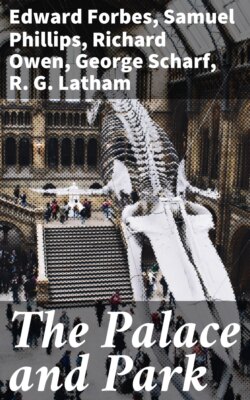Читать книгу The Palace and Park - Edward Winslow Forbes - Страница 43
PORTRAIT GALLERY,
ОглавлениеOne of the most ennobling and instructive as well as interesting of the collections in the Crystal Palace. These busts give us the speechless, yet how eloquent, countenances of the great ones who have moved the current of the world’s life, from early times till the present moment. Each one of these busts is inscribed with the name and dates of whomever it represents; but for a notice of the lives and general information as to the claims to renown of the several notabilities, we refer the visitor to the Handbook of the Portrait Gallery. A fine collection of small works of art, consisting of statuettes, mediæval pottery and wood-work, church vessels, old English seals, medals, and architectural ornaments, exemplifying the various styles from the Byzantine down to the Italian, is also arranged here.
In the North-east Galleries, on the garden side of the North Transept, is a Naval Museum, which is intended to illustrate the naval architecture of all countries. Here will be seen models of boats and ships, from the first rude canoe to the patent collapsing boats; and from the huge high-pooped ship of war of the time of Henry the Eighth, and Philip of Spain, to the long screw steamer of the present day; or the gigantic paddle and screw “Leviathan,” lately launched at Millwall, together with various inventions for marine purposes. In the first gallery, at the extreme north end of the Nave, a collection is exhibited of engineering and architectural models, including those of bridges, docks, viaducts, churches, and other structures.
Entering the gallery by the stairs from the garden end of the North Transept, one of the first models we meet is in illustration of Mr. Fergusson’s System of Fortification. The great principle of this system is the power of placing in position on a fortified place a greater number of guns than the enemy can bring to bear upon any point of it. For this purpose, Mr. Fergusson proposes to erect simple mounds of earth, bearing two or three tiers of guns, where the place is large and the curve flat, and four or even five tiers, where the space is confined. The model represents a small confined space surrounded by five tiers; ensuring in his opinion, a superiority of fire over anything that can be brought against it. Mr. Fergusson proposes to employ wet ditches wherever water is available; but on dry or uneven ground, a ditch of fifty or sixty feet, with a loop-holed wall at the bottom, not less than thirty feet high, thoroughly flanked in every part by musketry and artillery from the small bastions placed at intervals along its fronts. The model represents upon its different faces, suggestions for various methods of arming the ramparts and of flanking defences.
Amongst the various ingenious and beautiful objects in this part of the gallery will be remarked models of the Kieff Suspension Bridge, the original of which is nearly half-a-mile long, over the river Dneiper; the Britannia Tubular Bridge; the Wrought Iron Bridge over the Wye, at Chepstow; and one of a similar construction over the river Tamar, at Saltash. Most of these, as also the fine Viaducts, of which many are represented, are due to the giant enterprise which steam traffic raised in our country. There are two crystal models here of the Great Exhibition Palace in Hyde Park; one, the largest, by Mr. Dighton, of London, on the scale of half an inch to the foot, is especially beautiful and complete.
